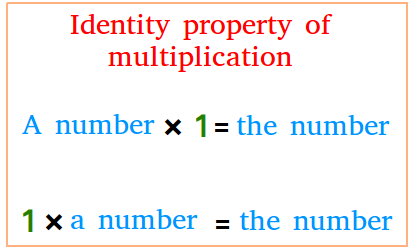Identity property of multiplication
The identity property of multiplication, also called the multiplication property of one says that a number does not change when that number is multiplied by 1.
You can see this property readily with a printable multiplication chart. Display the chart in front of your student and have them look at the products in the first row or column.
Again, as you can see in the figure below, the concept says that any number number multiplied by 1 gives the same number.

If they get the point, they will say 25 billion and it proves that the size of the number does not matter.
Believe it or not, some students were confused and gave me a different answer. I hope you got the point!
Other examples showing the identity property of multiplication.
3 × 1 = 3-20 × 1 = -20
1 × y = y
10 × 1 = 10
6 × 1 = 6
-z × 1 = -z
68 × 1 = 68
1 × 4 = 4
1 × -9 = - 9
x × 1 = x
(a + b) × 1 = a + b
Multiplicative inverse property
If you multiply two numbers and the product is 1, we call the two numbers multiplicative inverses or reciprocals of each other.
For example, 4 is the multiplicative inverse of 1/4 because 4 × 1/4 = 1.
1/4 is also the multiplicative inverse of 4 because 1/4 × 4 = 1.
Notice that the multiplicative inverse of 1 is 1 since 1 × 1 is 1 . By the same token, the multiplicative inverse of -1 is -1 since -1 × -1 is 1. In fact, 1 and -1 are the only two numbers that can be their own multiplicative inverse.
A few examples showing the identity property of division
2 ÷ 1 = 2
x ÷ 1 = x
-5 ÷ 1 = -5
2 ÷ 1 = 2
50 ÷ 1 = 50
-x ÷ 1 = -x
|
Test your knowledge with the quiz below: |